Futures Calls Recap for 9/1/16
Things did not pick up for the start of September, so we are probably done for the week. Mixed results on the Opening Range plays but ended up green. NASDAQ volume was only 1.2 billion shares.
Net ticks: +14 ticks.
As usual, let's start by taking a look at the ES and NQ with our market directional lines, VWAP, and Comber on the 5-minute chart from today's session:
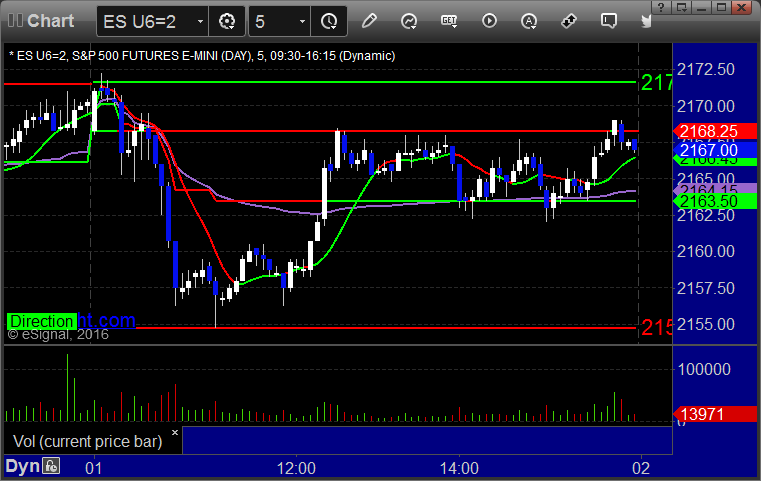
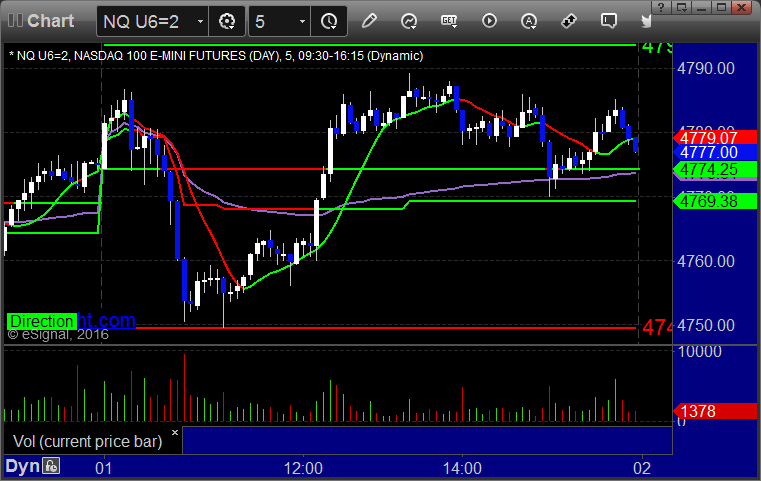
ES and NQ Opening and Institutional Range Plays:
ES Opening Range Play triggered long at A and stopped, unfortunately, then triggered short at B and worked enough for a partial:
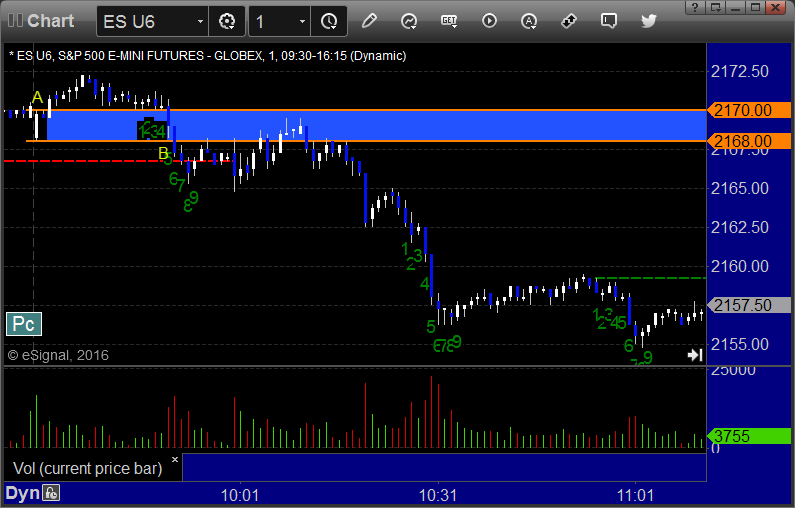
NQ Opening Range Play triggered long at A and worked enough for a partial then triggered short at B and worked:
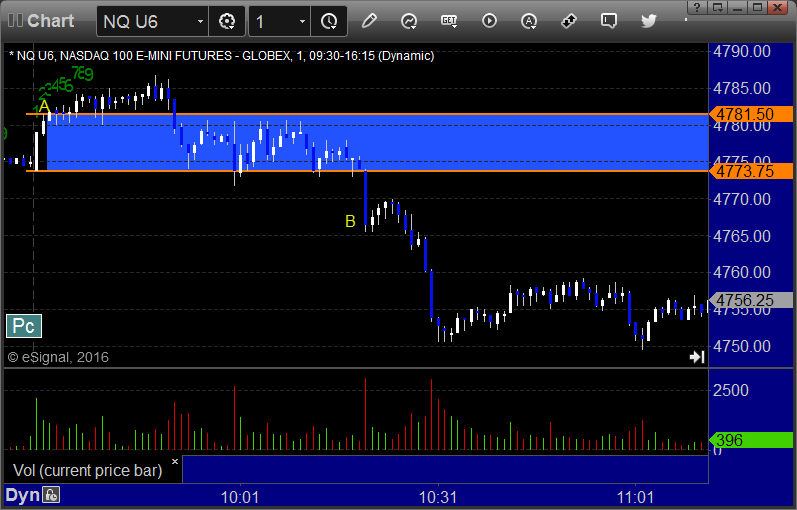
ES Tradesight Institutional Range Play:
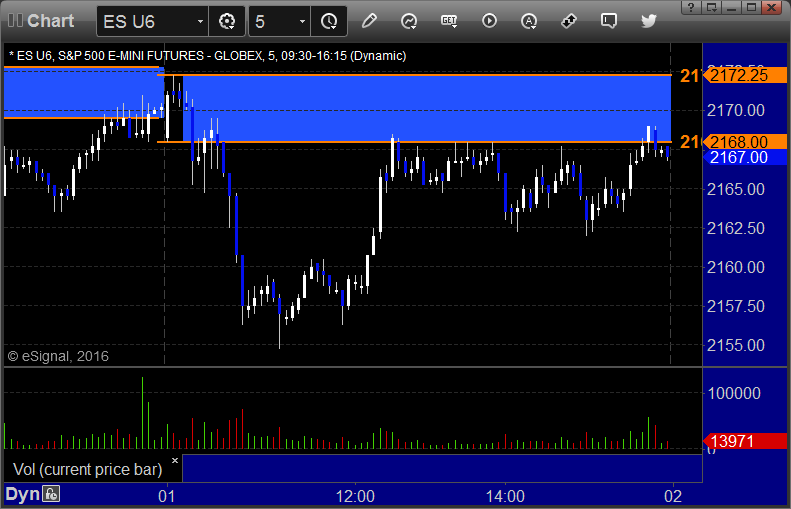
NQ Tradesight Institutional Range Play:
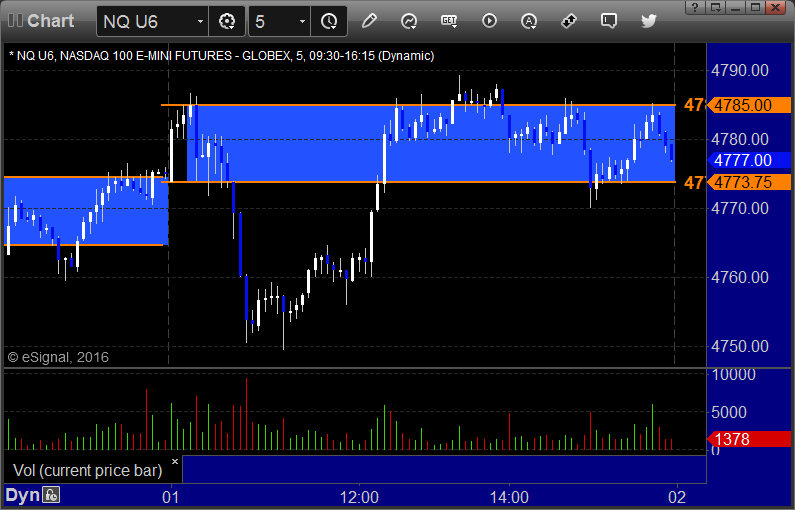
ES:
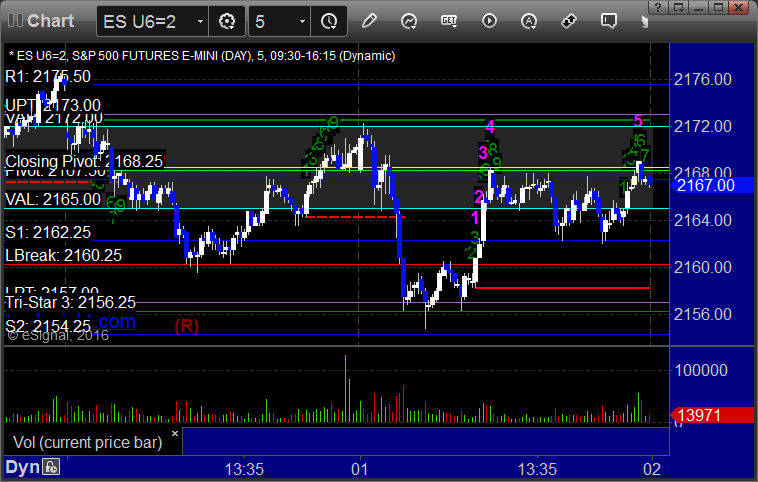
Forex Calls Recap for 9/1/16
No trades for the session as we had a rare and unexpected news gap on the GBP-based pairs that took us right through the GBPUSD long entry. See that section below.
Here's a look at the US Dollar Index intraday with our market directional lines:
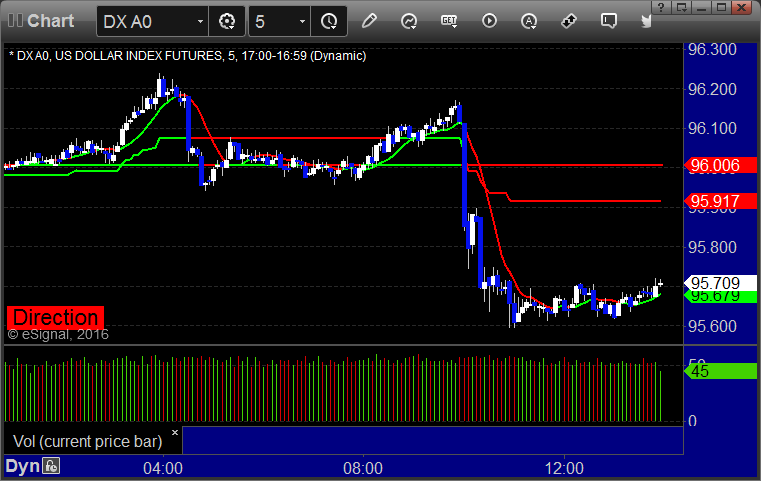
GBPUSD:
Long trigger would have been over R1 at A, but we gapped through it on news:
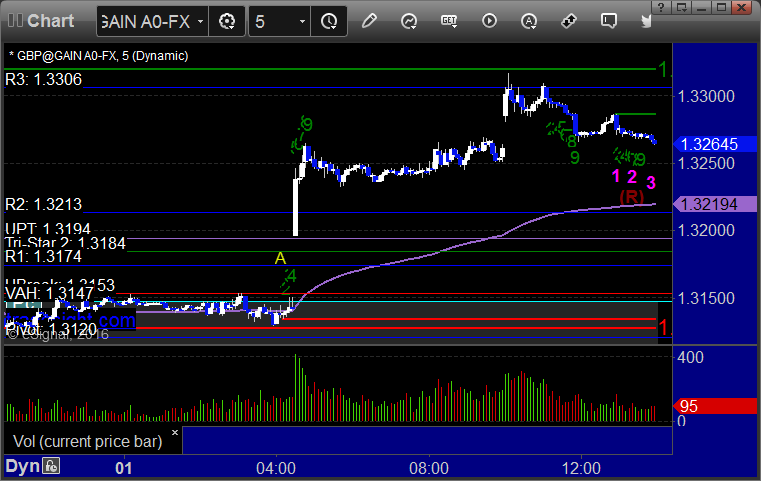
Tradesight July 2016 Stock Results
Tradesight has been providing stock calls daily since 2002. We post the results of our of our trades, winners and losers, in our reports and Market Blog every day. Some people might find it surprising to learn that while we track our Futures and Forex formal trade call results monthly, we don’t post anything beyond the trade reviews on our Stocks calls.
There is actually a very specific reason for this. I’ve never been a fan of trying to “hype” or “promote” something. Being profitable in trading is about learning what to do and getting yourself to make the right decisions. In Futures as well as in Forex, if we publish a call in advance, just about everyone should get the same fills and be able to get in and out at almost the same numbers. That isn’t always the case in stocks. It depends on how many shares you are trading and what the liquidity in the market for that stock is at the time. For that reason, I have already been hesitant to say “These are the exact results.” I would never want to try to suggest that someone would make a certain amount of dollars trading a certain number of shares or make a certain percentage. If I take a trade and sell it for a $0.30 gain, it makes a big statistical difference if someone else had to pay $0.05 more to get in and maybe got out for $0.02 less. That’s $0.23 instead of $0.30 even though the concept of the trade was fine.
However, after many requests, in October 2015, we started posting our results. You can see these monthly here.
In our system, you can basically break trades down into four categories: Big losers, small losers, small winners, and big winners.
In order to have any chance of succeeding in the markets, you have to have a system. There is no other way around it. I’ve been trading for 20 years now, and I’ve trained over 1000 people. You don’t make money if you don’t have a technically valid system for entry and exits.
Of the four categories of trades listed above, we simply don’t allow any of the first category, which is big losers. We always have a worst-case stop and we always stick to it. There should never be a scenario where you are still in a trade that is causing a significant loss if you follow our rules.
In terms of the other three categories, generally speaking, if you have about a third of your trades fall into each category, you should be making good money. In other words, if we have about 33% of our trades as small losers and 33% of trades as small winners, those basically would offset. That leaves the other 33% of so only as bigger winners, and that’s what we are here for. In our world, we count a loser as a trade that stops out (stops in our system are based on the price-level of the stock). We count a small winner as a trade that goes enough to make a partial and then either stops the second half of the trade under the entry or stops the second half of the trade slightly in the money, but no more than the partial was or so. Then the big winners are anything that keeps going beyond the partial.
So these were the results for June, which you can view here.
Tradesight Stock Results for June 2016
Number of trade calls that triggered with market support: 73
Number (and percent of total) of small losers: 11 (15.1%)
Number (and percent of total) of small winners: 30 (41.1%)
Number (and percent of total) of big winners: 32 (43.8%)
And for July?
Tradesight Stock Results for July 2016
Number of trade calls that triggered with market support: 63
Number (and percent of total) of small losers: 20 (31.7%)
Number (and percent of total) of small winners: 18 (28.6%)
Number (and percent of total) of big winners: 25 (39.7%)
Definitely a return to the mean after two months that exceeded our percentage goals by a lot. Here, we came back to almost a third of the trades as small losers, which is in the parameters, but is light compared to the prior couple of months. Still, we have almost 40% good winners and almost 70% winners overall. The other shift here is that we only had 63 trades trigger with market support. Granted, you lose a day or two in July to the Fourth of July Holiday, but also, volume is lower, which means less trades trigger. It's actually a solid month, especially considering the time of year.
Stock Picks Recap for 8/31/16
With each stock's recap, we will include a (with market support) or (without market support) tag, designating whether the trade triggered with or without market directional support at the time. Anything in the first five minutes will be considered WITHOUT market support because market direction cannot be determined that early. ETF calls do not require market support, and are thus either winners or losers.
From the report, nothing triggered.
From the Messenger/Tradesight_st Twitter Feed, Mark's CELG triggered short (without market support) and didn't work:
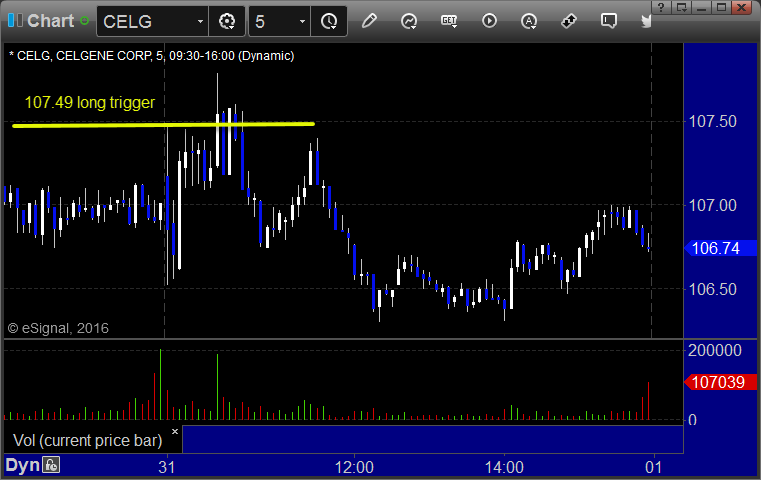
In total, that's 0 trades triggering with market support.
Futures Calls Recap for 8/31/16
No surprise that the last day of the month of August was going to be dead to start. Opening Range plays didn't even work net (ES worked, NQ did not). No point in calls although there were a few Levels setups. NASDAQ volume 1.5 billion shares, but only because of some big "end of month" prints at the close. Two days left.
Net ticks: -25.5 ticks.
As usual, let's start by taking a look at the ES and NQ with our market directional lines, VWAP, and Comber on the 5-minute chart from today's session:


ES and NQ Opening and Institutional Range Plays:
ES Opening Range Play triggered short at A and worked eventually:

NQ Opening Range Play triggered short at A and stopped, triggered long at B and stopped:

ES Tradesight Institutional Range Play:

NQ Tradesight Institutional Range Play:

ES:
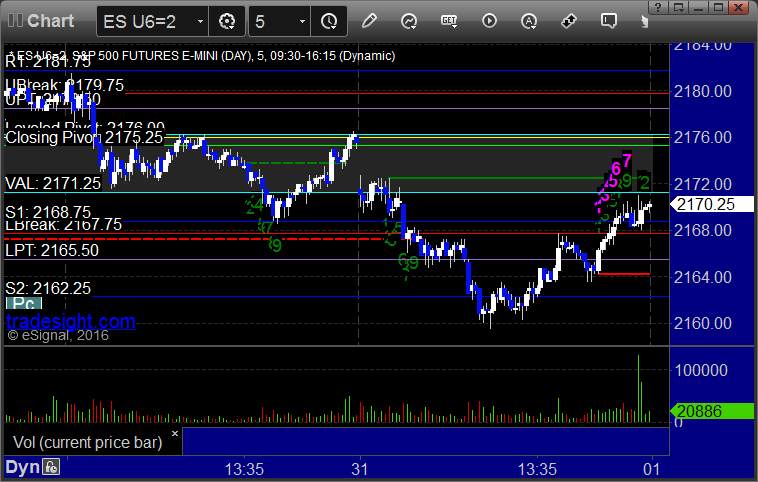
Forex Calls Recap for 8/31/16
A trade that would have worked out but just barely stopped first, unfortunately. See the GBPUSD section below.
Here's a look at the US Dollar Index intraday with our market directional lines:
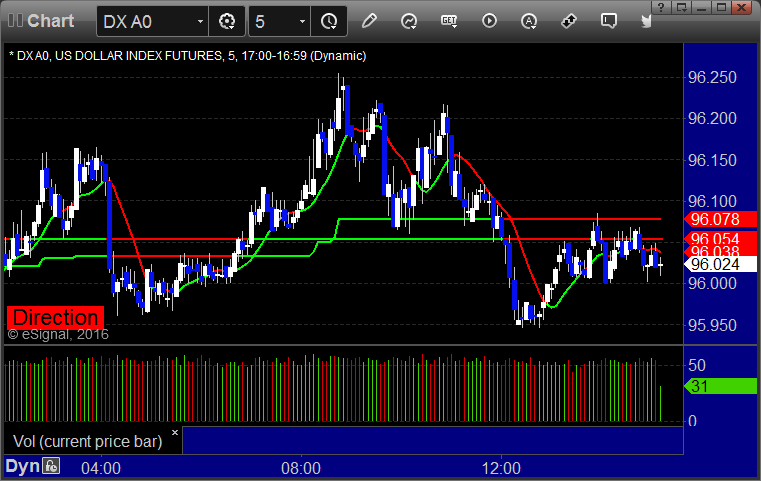
GBPUSD:
Triggered long at A and just barely stopped, but then went on to work if you were awake to take it again:
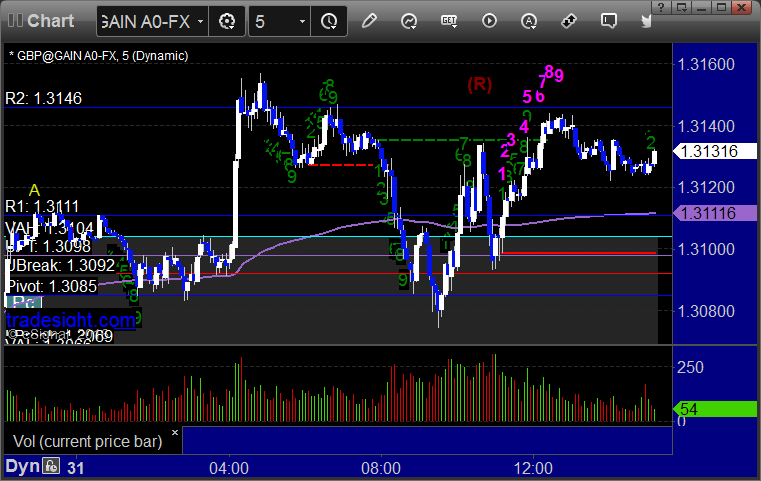
Stock Picks Recap for 8/30/16
With each stock's recap, we will include a (with market support) or (without market support) tag, designating whether the trade triggered with or without market directional support at the time. Anything in the first five minutes will be considered WITHOUT market support because market direction cannot be determined that early. ETF calls do not require market support, and are thus either winners or losers.
From the report, nothing triggered.
From the Messenger/Tradesight_st Twitter Feed, despite the fact that we had a total of 5 calls, nothing triggered (two set the triggers exactly), which says a lot about the state of the market.
In total, that's 0 trades triggering with market support. A rare event.
Futures Calls Recap for 8/30/16
The markets opened fairly flat and we got mixed results out of the Opening Range plays for a wash. Nothing else worth noting as we made two minor pushes lower and recovered both times on a weak 1.3 billion NASDAQ shares.
Net ticks: +0 ticks.
As usual, let's start by taking a look at the ES and NQ with our market directional lines, VWAP, and Comber on the 5-minute chart from today's session:


ES and NQ Opening and Institutional Range Plays:
ES Opening Range Play triggered short at A and I closed for a 4 tick loss after the 30 minute mark:

NQ Opening Range Play triggered long at A and worked enough for a partial:

ES Tradesight Institutional Range Play:

NQ Tradesight Institutional Range Play:

ES:
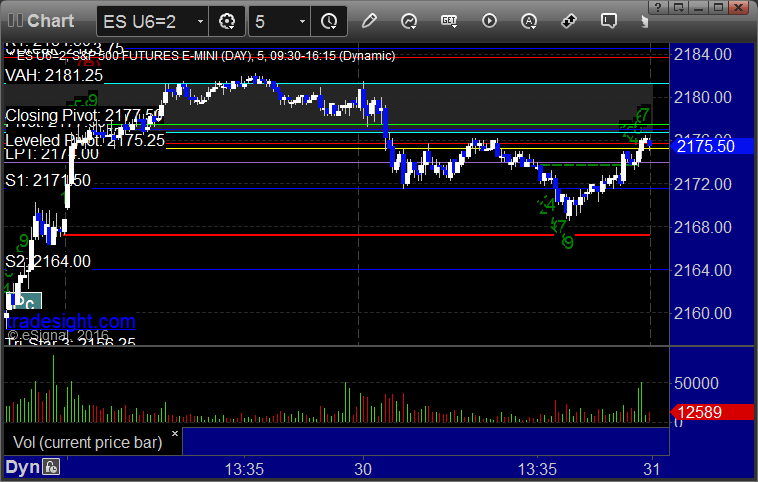
Forex Calls Recap for 8/30/16
Another boring night with the GBPUSD stuck in a 60 pips range. See that section below.
Here's a look at the US Dollar Index intraday with our market directional lines:
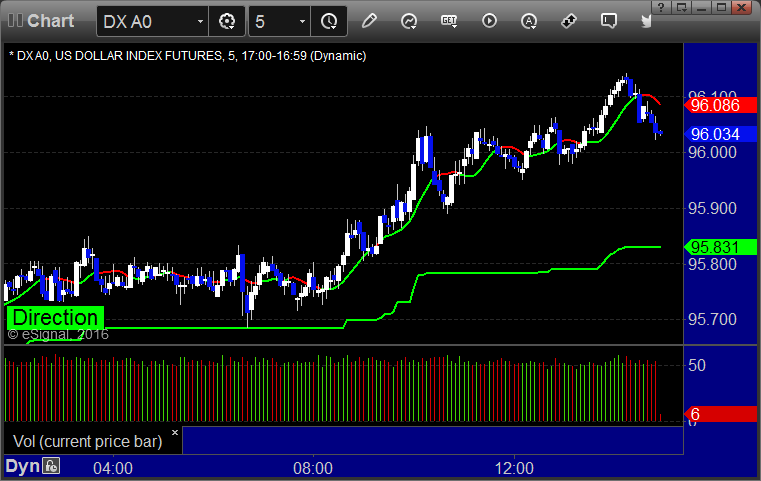
GBPUSD:
If you used our order staggering rules, part but not all of the short triggered at A and stopped:
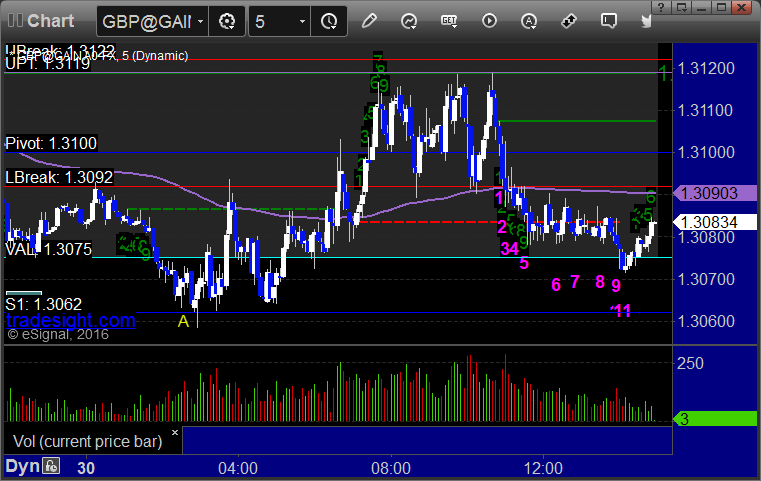
Stock Picks Recap for 8/29/16
With each stock's recap, we will include a (with market support) or (without market support) tag, designating whether the trade triggered with or without market directional support at the time. Anything in the first five minutes will be considered WITHOUT market support because market direction cannot be determined that early. ETF calls do not require market support, and are thus either winners or losers.
From the report, DNKN triggered long (with market support) and ultimately went enough for a partial but didn't do much considering the pattern:
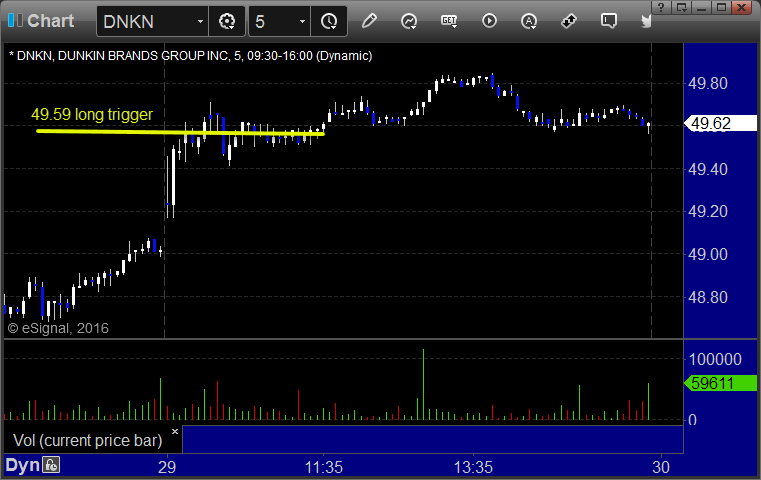
From the Messenger/Tradesight_st Twitter Feed, Mark's GILD triggered short (without market support) and worked:
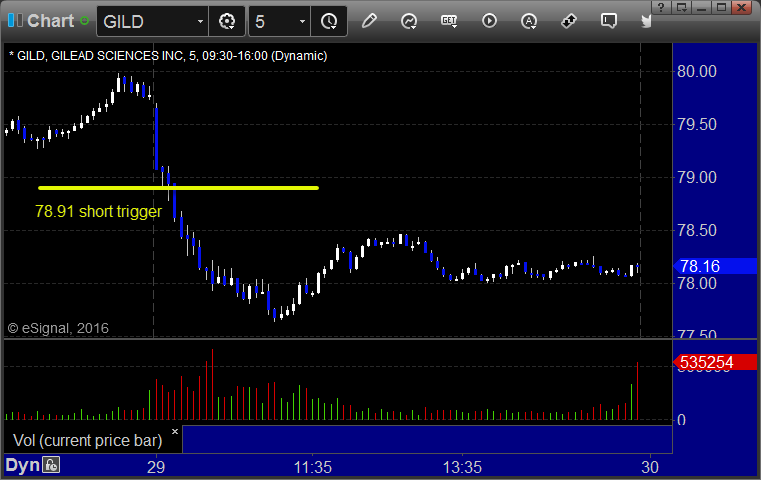
TSLA triggered short (without market support) and didn't work:
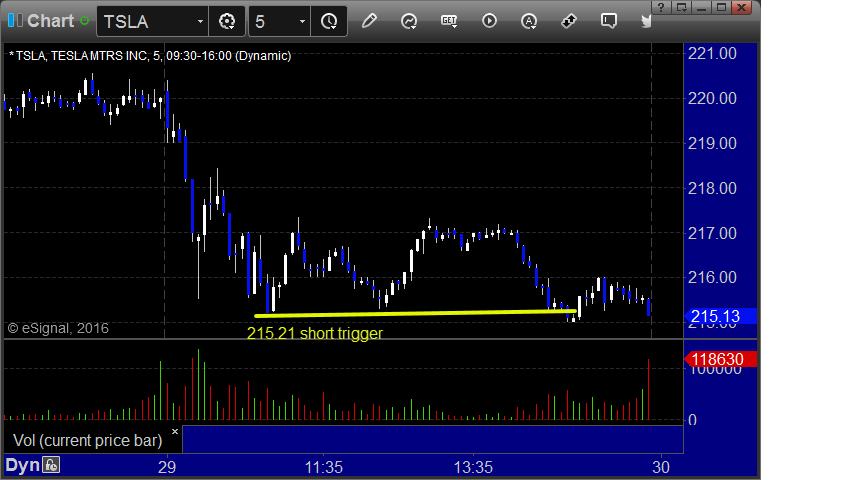
FB triggered long (with market support) and worked:

In total, that's 2 trades triggering with market support, both of them worked.
